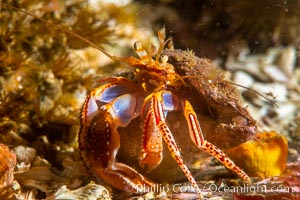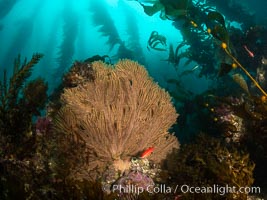
California golden gorgonian and small juvenile sheephead fishes on rocky reef, below kelp forest, underwater. The golden gorgonian is a filter-feeding temperate colonial species that lives on the rocky bottom at depths between 50 to 200 feet deep. Each individual polyp is a distinct animal, together they secrete calcium that forms the structure of the colony. Gorgonians are oriented at right angles to prevailing water currents to capture plankton drifting by.
Species: California golden gorgonian, Muricea californica
Location: San Clemente Island, California
Image ID: 37057
Species: California golden gorgonian, Muricea californica
Location: San Clemente Island, California
Image ID: 37057
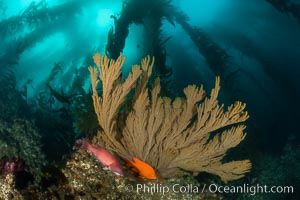
Sheephead wrasse, Garibaldi and golden gorgonian, with a underwater forest of giant kelp rising in the background, underwater.
Species: California golden gorgonian, Garibaldi, Hypsypops rubicundus, Muricea californica
Location: San Clemente Island, California
Image ID: 37093
Species: California golden gorgonian, Garibaldi, Hypsypops rubicundus, Muricea californica
Location: San Clemente Island, California
Image ID: 37093
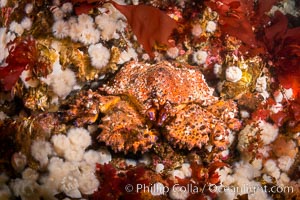
Lopholithodes mandtii Puget Sound King Crab amid a field of plumose anemones and red kelp, Queen Charlotte Strait, Canada.
Species: Puget sound king crab, Lopholithodes mandtii
Location: British Columbia, Canada
Image ID: 34348
Species: Puget sound king crab, Lopholithodes mandtii
Location: British Columbia, Canada
Image ID: 34348
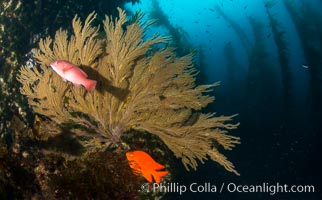
California golden gorgonian, Garibaldi and Sheephead wrasse fishes on rocky reef, below kelp forest, underwater. The golden gorgonian is a filter-feeding temperate colonial species that lives on the rocky bottom at depths between 50 to 200 feet deep. Each individual polyp is a distinct animal, together they secrete calcium that forms the structure of the colony. Gorgonians are oriented at right angles to prevailing water currents to capture plankton drifting by.
Species: California golden gorgonian, California sheephead wrasse, Garibaldi, Hypsypops rubicundus, Muricea californica, Semicossyphus pulcher
Location: San Clemente Island, California
Image ID: 30922
Species: California golden gorgonian, California sheephead wrasse, Garibaldi, Hypsypops rubicundus, Muricea californica, Semicossyphus pulcher
Location: San Clemente Island, California
Image ID: 30922
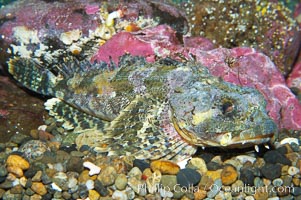
Red Irish Lord. The red irish lord lurks in shallow habitats where it feeds on crabs, shrimp, barnacles, mussels and small fishes.
Species: Red irish lord, Hemilepidotus hemilepidotus
Image ID: 13689
Species: Red irish lord, Hemilepidotus hemilepidotus
Image ID: 13689
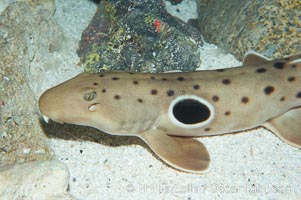
Epaulette shark. The epaulette shark is primarily nocturnal, hunting for crabs, worms and invertebrates by crawling across the bottom on its overlarge fins.
Species: Epaulette shark, Hemiscyllium ocellatum
Image ID: 14958
Species: Epaulette shark, Hemiscyllium ocellatum
Image ID: 14958
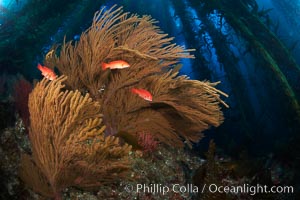
California golden gorgonian and small juvenile sheephead fishes on rocky reef, below kelp forest, underwater. The golden gorgonian is a filter-feeding temperate colonial species that lives on the rocky bottom at depths between 50 to 200 feet deep. Each individual polyp is a distinct animal, together they secrete calcium that forms the structure of the colony. Gorgonians are oriented at right angles to prevailing water currents to capture plankton drifting by.
Species: California golden gorgonian, Muricea californica, Semicossyphus pulcher
Location: San Clemente Island, California
Image ID: 23421
Species: California golden gorgonian, Muricea californica, Semicossyphus pulcher
Location: San Clemente Island, California
Image ID: 23421
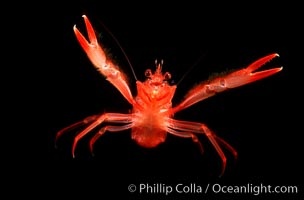
Pelagic red tuna crab, open ocean.
Species: Pelagic red crab, Pleuroncodes planipes
Location: San Diego, California
Image ID: 02247
Species: Pelagic red crab, Pleuroncodes planipes
Location: San Diego, California
Image ID: 02247
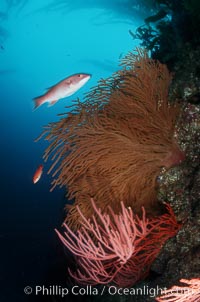
California Golden gorgonian, red gorgonian, sheephead.
Species: California golden gorgonian, Red gorgonian, Leptogorgia chilensis, Lophogorgia chilensis, Muricea californica, Semicossyphus pulcher
Location: San Clemente Island, California
Image ID: 02533
Species: California golden gorgonian, Red gorgonian, Leptogorgia chilensis, Lophogorgia chilensis, Muricea californica, Semicossyphus pulcher
Location: San Clemente Island, California
Image ID: 02533
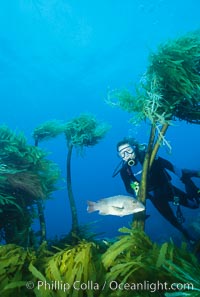
Diver and sheephead amidst giant palm kelp. Southern sea palm.
Species: Southern sea palm, Eisenia arborea
Location: Guadalupe Island (Isla Guadalupe), Baja California, Mexico
Image ID: 00612
Species: Southern sea palm, Eisenia arborea
Location: Guadalupe Island (Isla Guadalupe), Baja California, Mexico
Image ID: 00612
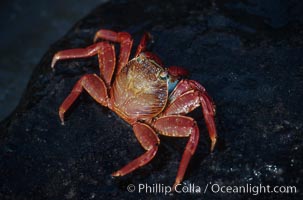
Sally Lightfoot crab.
Species: Sally lightfoot crab, Grapsus grapsus
Location: Galapagos Islands, Ecuador
Image ID: 01896
Species: Sally lightfoot crab, Grapsus grapsus
Location: Galapagos Islands, Ecuador
Image ID: 01896
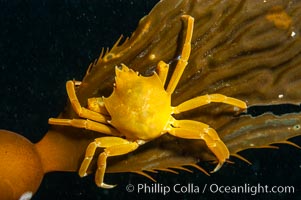
Northern kelp crab crawls amidst kelp blades and stipes, midway in the water column (below the surface, above the ocean bottom) in a giant kelp forest.
Species: Northern kelp crab, Macrocystis pyrifera, Pugettia producta
Location: San Nicholas Island, California
Image ID: 10218
Species: Northern kelp crab, Macrocystis pyrifera, Pugettia producta
Location: San Nicholas Island, California
Image ID: 10218
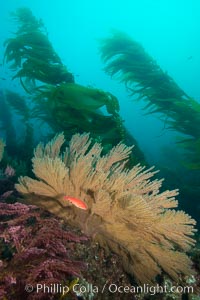
California golden gorgonian and small juvenile sheephead fishes on rocky reef, below kelp forest, underwater. The golden gorgonian is a filter-feeding temperate colonial species that lives on the rocky bottom at depths between 50 to 200 feet deep. Each individual polyp is a distinct animal, together they secrete calcium that forms the structure of the colony. Gorgonians are oriented at right angles to prevailing water currents to capture plankton drifting by.
Species: California sheephead wrasse, Semicossyphus pulcher
Location: San Clemente Island, California
Image ID: 30903
Species: California sheephead wrasse, Semicossyphus pulcher
Location: San Clemente Island, California
Image ID: 30903
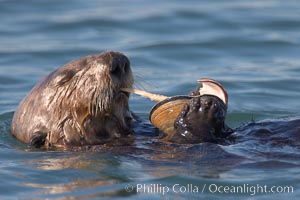
A sea otter eats a clam that it has taken from the shallow sandy bottom of Elkhorn Slough. Because sea otters have such a high metabolic rate, they eat up to 30% of their body weight each day in the form of clams, mussels, urchins, crabs and abalone. Sea otters are the only known tool-using marine mammal, using a stone or old shell to open the shells of their prey as they float on their backs.
Species: Sea otter, Enhydra lutris
Location: Elkhorn Slough National Estuarine Research Reserve, Moss Landing, California
Image ID: 21612
Species: Sea otter, Enhydra lutris
Location: Elkhorn Slough National Estuarine Research Reserve, Moss Landing, California
Image ID: 21612
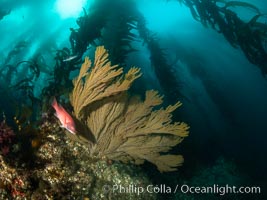
California golden gorgonian and small juvenile sheephead fishes on rocky reef, below kelp forest, underwater. The golden gorgonian is a filter-feeding temperate colonial species that lives on the rocky bottom at depths between 50 to 200 feet deep. Each individual polyp is a distinct animal, together they secrete calcium that forms the structure of the colony. Gorgonians are oriented at right angles to prevailing water currents to capture plankton drifting by.
Species: California golden gorgonian, Muricea californica
Location: San Clemente Island, California
Image ID: 37095
Species: California golden gorgonian, Muricea californica
Location: San Clemente Island, California
Image ID: 37095
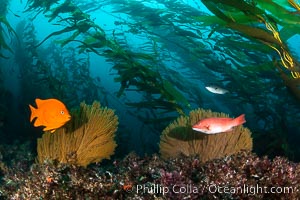
Garibaldi, juvenile sheephead and California golden gorgonian on underwater rocky reef, San Clemente Island. The golden gorgonian is a filter-feeding temperate colonial species that lives on the rocky bottom at depths between 50 to 200 feet deep. Each individual polyp is a distinct animal, together they secrete calcium that forms the structure of the colony. Gorgonians are oriented at right angles to prevailing water currents to capture plankton drifting by.
Species: California golden gorgonian, Giant kelp, Garibaldi, Muricea californica, Macrocystis pyrifera, Hypsypops rubicundus
Location: San Clemente Island, California
Image ID: 38522
Species: California golden gorgonian, Giant kelp, Garibaldi, Muricea californica, Macrocystis pyrifera, Hypsypops rubicundus
Location: San Clemente Island, California
Image ID: 38522
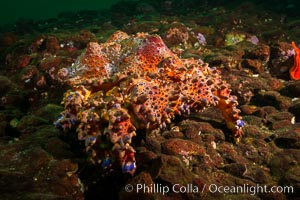
Lopholithodes mandtii, Puget Sound King Crab, Hornby Island, Canada.
Species: Puget sound king crab, Lopholithodes mandtii
Location: Hornby Island, British Columbia, Canada
Image ID: 32822
Species: Puget sound king crab, Lopholithodes mandtii
Location: Hornby Island, British Columbia, Canada
Image ID: 32822
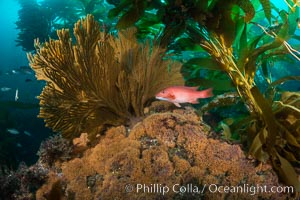
California golden gorgonian and Sheephead wrasse fish on rocky reef, below kelp forest, underwater. The golden gorgonian is a filter-feeding temperate colonial species that lives on the rocky bottom at depths between 50 to 200 feet deep. Each individual polyp is a distinct animal, together they secrete calcium that forms the structure of the colony. Gorgonians are oriented at right angles to prevailing water currents to capture plankton drifting by.
Location: Catalina Island, California
Image ID: 34183
Location: Catalina Island, California
Image ID: 34183
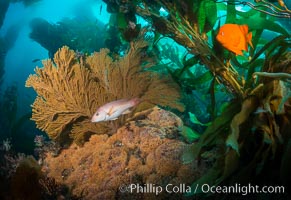
California golden gorgonian, Garibaldi and Sheephead wrasse fishes on rocky reef, below kelp forest, underwater. The golden gorgonian is a filter-feeding temperate colonial species that lives on the rocky bottom at depths between 50 to 200 feet deep. Each individual polyp is a distinct animal, together they secrete calcium that forms the structure of the colony. Gorgonians are oriented at right angles to prevailing water currents to capture plankton drifting by.
Location: Catalina Island, California
Image ID: 34186
Location: Catalina Island, California
Image ID: 34186
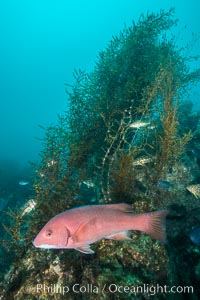
Sheephead and invasive sargassum, Catalina.
Species: Sargassum, Sheephead wrasse, Sargassum horneri, Semicossyphus pulcher
Location: Catalina Island, California
Image ID: 30974
Species: Sargassum, Sheephead wrasse, Sargassum horneri, Semicossyphus pulcher
Location: Catalina Island, California
Image ID: 30974
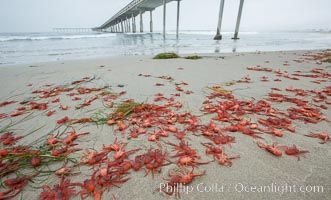
Pelagic red tuna crabs, washed ashore to form dense piles on the beach.
Species: Pelagic red crab, Pleuroncodes planipes
Location: Ocean Beach, California
Image ID: 30982
Species: Pelagic red crab, Pleuroncodes planipes
Location: Ocean Beach, California
Image ID: 30982
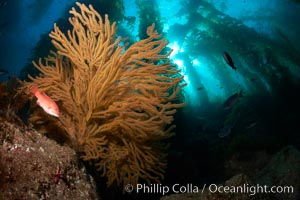
California sheephead and golden gorgonian, giant kelp forest filters sunlight in the background, underwater.
Species: California sheephead wrasse, Muricea californica, Semicossyphus pulcher
Location: Catalina Island, California
Image ID: 23449
Species: California sheephead wrasse, Muricea californica, Semicossyphus pulcher
Location: Catalina Island, California
Image ID: 23449
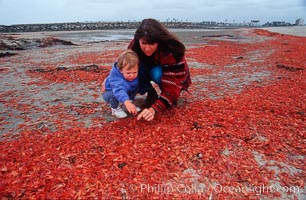
Pelagic red tuna crabs, washed ashore to form dense piles on the beach.
Species: Pelagic red crab, Pleuroncodes planipes
Location: Ocean Beach, California
Image ID: 06068
Species: Pelagic red crab, Pleuroncodes planipes
Location: Ocean Beach, California
Image ID: 06068
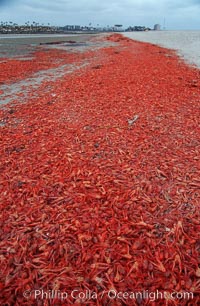
Pelagic red tuna crabs, washed ashore to form dense piles on the beach.
Species: Pelagic red crab, Pleuroncodes planipes
Location: Ocean Beach, California
Image ID: 06077
Species: Pelagic red crab, Pleuroncodes planipes
Location: Ocean Beach, California
Image ID: 06077
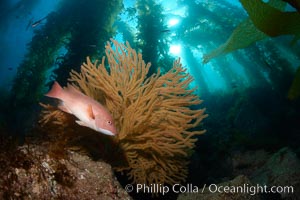
California sheephead and golden gorgonian, giant kelp forest filters sunlight in the background, underwater.
Species: California sheephead wrasse, Muricea californica, Semicossyphus pulcher
Location: Catalina Island, California
Image ID: 23472
Species: California sheephead wrasse, Muricea californica, Semicossyphus pulcher
Location: Catalina Island, California
Image ID: 23472
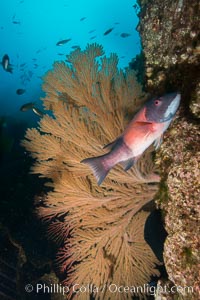
California golden gorgonian and Sheephead wrasse fishes on rocky reef, below kelp forest, underwater. The golden gorgonian is a filter-feeding temperate colonial species that lives on the rocky bottom at depths between 50 to 200 feet deep. Each individual polyp is a distinct animal, together they secrete calcium that forms the structure of the colony. Gorgonians are oriented at right angles to prevailing water currents to capture plankton drifting by.
Species: California sheephead wrasse, Semicossyphus pulcher
Location: San Clemente Island, California
Image ID: 30888
Species: California sheephead wrasse, Semicossyphus pulcher
Location: San Clemente Island, California
Image ID: 30888
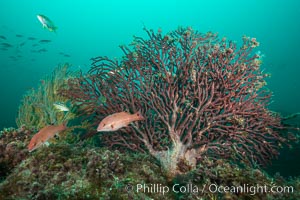
Juvenile sheephead and gorgonian, Catalina.
Species: Sheephead wrasse, Semicossyphus pulcher
Location: Catalina Island, California
Image ID: 30975
Species: Sheephead wrasse, Semicossyphus pulcher
Location: Catalina Island, California
Image ID: 30975
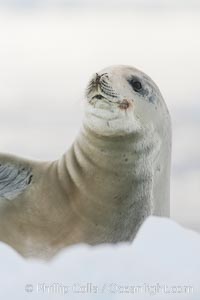
A crabeater seal, hauled out on pack ice to rest. Crabeater seals reach 2m and 200kg in size, with females being slightly larger than males. Crabeaters are the most abundant species of seal in the world, with as many as 75 million individuals. Despite its name, 80% the crabeater seal's diet consists of Antarctic krill. They have specially adapted teeth to strain the small krill from the water.
Species: Crabeater seal, Lobodon carcinophagus
Location: Neko Harbor, Antarctic Peninsula, Antarctica
Image ID: 25663
Species: Crabeater seal, Lobodon carcinophagus
Location: Neko Harbor, Antarctic Peninsula, Antarctica
Image ID: 25663
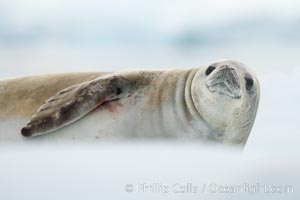
A crabeater seal, hauled out on pack ice to rest. Crabeater seals reach 2m and 200kg in size, with females being slightly larger than males. Crabeaters are the most abundant species of seal in the world, with as many as 75 million individuals. Despite its name, 80% the crabeater seal's diet consists of Antarctic krill. They have specially adapted teeth to strain the small krill from the water.
Species: Crabeater seal, Lobodon carcinophagus
Location: Neko Harbor, Antarctic Peninsula, Antarctica
Image ID: 25665
Species: Crabeater seal, Lobodon carcinophagus
Location: Neko Harbor, Antarctic Peninsula, Antarctica
Image ID: 25665
